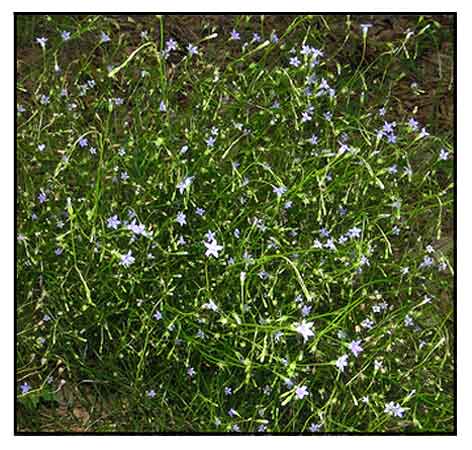 Gen info Gen info
- Wahlenbergia is a genus of around 260 species of flowering plants in the family Campanulaceae. Species are perennial or annual herbs with simple leaves and blue to purple bell-shaped flowers, usually with five petals.
- In 1814, Heinrich Schrader first used the name Wahlenbergia elongata, but the name was a nomen nudum (unpublished). The genus was first formally described in 1821 by Albrecht Wilhelm Roth and the description published in Roth's Novae Plantarum Species prasertim Indiae Orientalis. Roth kept Schrader's name Wahlenbergia, which honors Göran Wahlenberg, a Swedish botanist. (3)
- Etymology: Genus name Wahlenbergia honors the Swedish naturalist, Göran Wahlenberg
. The species epithet 'marginata' derives from Latin 'marg(in)' meaning 'border, edge', referring to where the plant is grows as it is commonly found along roadsides and disturbed areas. (8)
Botany
Wahlenbergia marginata is a perennial herb 3-60 cm tall, glabrous or hairy, woody at base. Leaves arranged spirally, simple, linear to elliptical, 1.5-5.5 cm × 0.1-0.5 cm, decreasing in size upwards, serrate to almost entire, mostly sessile; stipules absent. Inflorescence a 1-few-flowered, terminal or axillary raceme, with small bracts. Flowers bisexual, regular, 3-5-merous, distinctly protandrous; pedicel 1-15 cm long; calyx lobes 0.8-4 mm long; corolla tube 1-5 mm long, lobes ovate or elliptical, 1-7 mm long, acute or acuminate, violet-blue or white; stamens alternating with corolla lobes, free; ovary inferior, obconical to bell-shaped, 1-5 mm long, 2-3-celled, style 1.5-5 mm long, stigma 2-3-lobed. Fruit an obconical to bell-shaped capsule 1.5-10 mm × 1-5 mm, 2-3-valved, many-seeded. Seeds ellipsoid to triangular, up to 1 mm long, shining. (1)
 Distribution Distribution
- Native to the Philippines.
- Also native to Assam, Bangladesh, China, Himalaya, India, Japan, Jawa, Kazan-retto, Korea, Laos, Lesser Sunda Is., Maluku, Myanmar, Nansei-shoto, Nepal, New Guinea, Ogasawara-shoto, Sri-Lanka, Sulawesi, Taiwan, Thailand, Vietnam.
(2)
Constituents
- Study of methanol extract isolated wahlengergioside, a new hydroxymethylglutaroyl phenylpropanoid glucoside, and a known compound, lobetyolin. (4)
- Repeated column chromatography of aqueous methanol extract of whole plant isolated five compounds: Wahlenoside, a new natural product (1), demethyl syringin (2), 3,5-dihydroxyphenethyl alcohol 3-O-β-D-glucopyranoside (3), rutin (4), and isovitexin (5). (see study below) (9)
Properties
- Due to small size, plant is difficult to locate. Without flowers blooming, it is easily overlooked. (8)
-
Studies have suggest hepatoprotective properties.
Parts used
Roots, whole plant.
Uses
Folkloric
- Used for pulmonary infections.
- In Indonesia, used to treat skin eruptions.
- In Cambodia, Laos, and Vietnam, used to treat pulmonary infection.
-
In Java, used to treat skin diseases.
- In China, used for treatment of hepatitis.
- In China and Indo-China, roots used for cough and hemoptysis and for treatment of gastralgia.
- In Uttar Pradesh, India, paste prepared from whole plant used for skin troubles.
- In India, roots used for pulmonary infections. Herb used externally for skin diseases and strengthening loose teeth. (7)
Studies
• Biotechnology and Secondary Metabolites / Roots: Wahlenbergia marginata hairy roots were induced by infection with Agrobacterium rhizogenes ATCC 15834 and MAFF 03-01724 strains. The hairy roots produced high content of polyacetylenes, particularly the monoglucoside, lobetyolin. Agrobacterium-mediated gene transformation is an applicable method for getting useful transgenic W. marginata plantlets. (5)
• Hepatoprotective / Whole Plant: Study evaluated the hepatoprotective effect of aqueous methanol extract of whole plant of W. marginata against acute liver injury induced by Concanavalin A in mice. marginata. The extracts of W. marginata reduced the ALT/AST in blood serum of mice with acute liver injury, and relieved the damage in liver tissue. In search of active compounds, repeated column chromatography isolated five compounds: Wahlenoside, a new natural product (1), demethyl syringin (2), 3,5-dihydroxyphenethyl alcohol 3-O-β-D-glucopyranoside (3), rutin (4), and isovitexin (5). (9)
Availability
Wild-crafted. |

![]()





